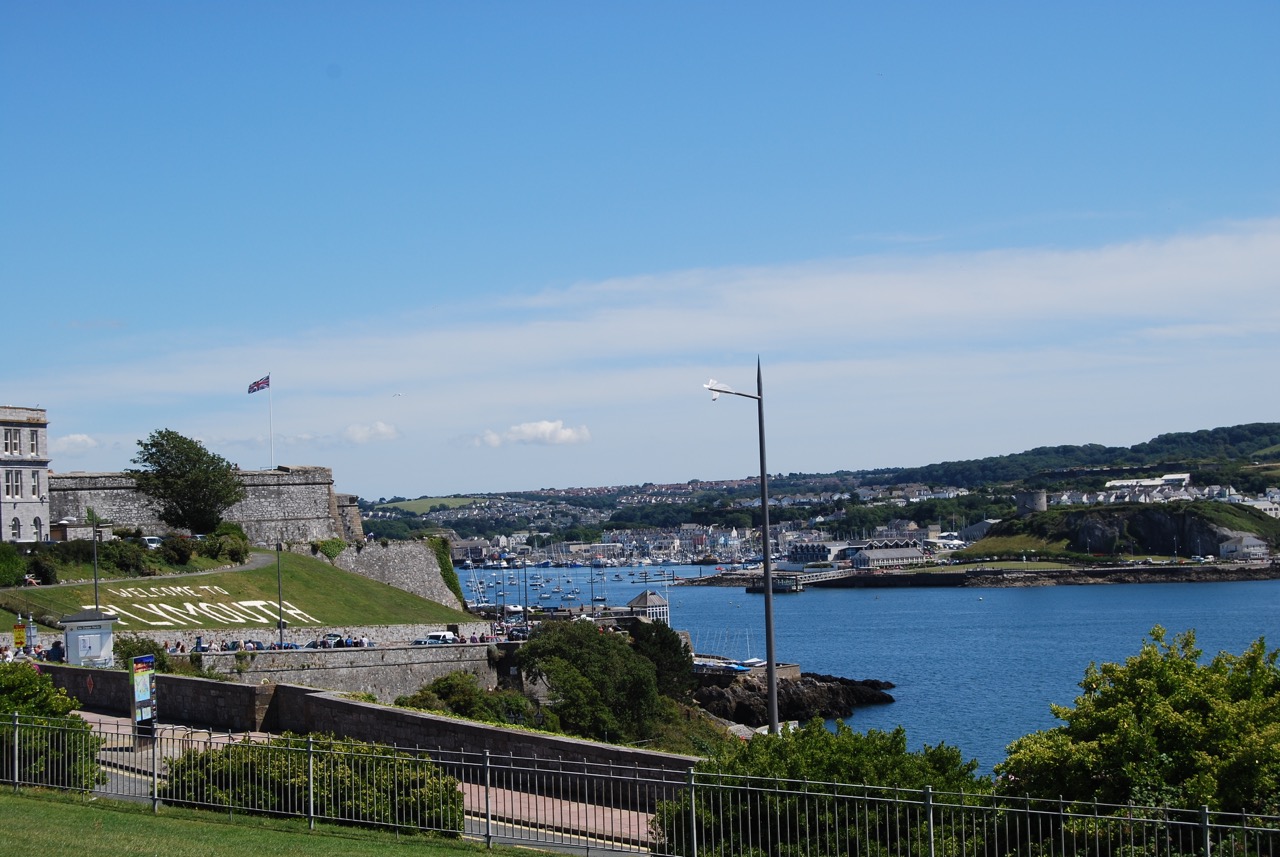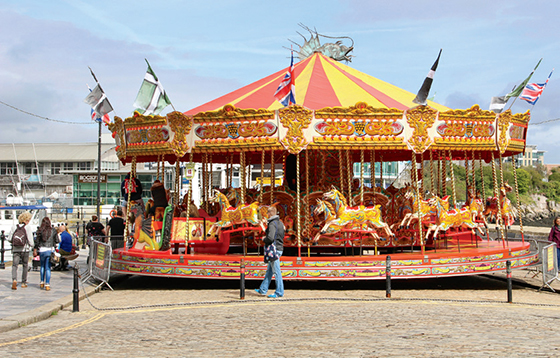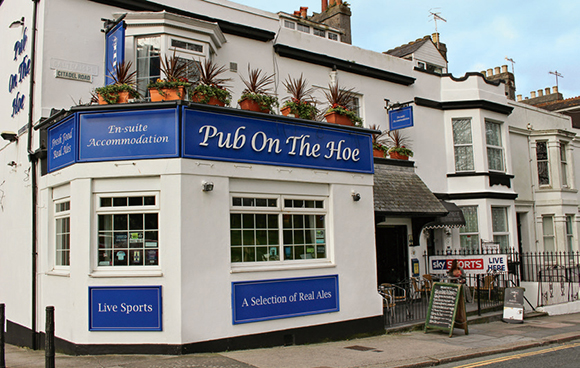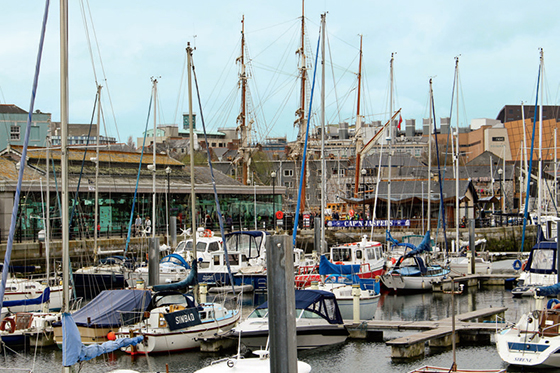
Plymouth, in south west England.
Explore The Barbican and play bowls on The Hoe with Drake.
On the border of Devon and Cornwall, some 200 miles from London, England’s southwesternmost major port has played a dramatic role in the nation’s maritime history and defense. That reality is evidenced by the city’s appearance today, whether you arrive by road or train. The city appears to look too young for its history. Alas, Plymouth’s importance during World War II resulted in the city and its harbor sustaining widespread devastation from the German bombing. The modern city today is largely built on those ashes.
Just as there is with any historic English city, Plymouth has multiple layers that can repay several days of exploration. This is one of those places, however, where its unique culture and heritage are concentrated in an area that can easily be covered by foot. Miraculously, Plymouth’s inner harbor neighborhood known as the Barbican and the broad plateau above it, Plymouth Hoe, largely survived the 20th-century destruction intact—yet are largely overlooked by heritage travelers like savvy British Heritage readers.
In the maritime, island Great Britain, Plymouth’s self-assumed moniker as the “Ocean City” might seem a little presumptive. As Britain’s westernmost principal port, however, Plymouth lies just where the English Channel broadens into the open Atlantic, with unbroken water west to North America. Plymouth alone of the island’s cities faces the Atlantic Ocean.
Destination Plymouth
Plymouth isn’t the sort of place you would just set out driving to as a sole destination. It is just too many miles from London, and there are too many other great heritage destinations on the way. As a two-night stopover on a West Country itinerary, though, Plymouth makes a great visit. By train from London Paddington, Plymouth makes a marvelous destination with a roughly four-hour rail journey through the archetypical English countryside and along the gorgeous Devon coast.
Planning a Stay
Location is everything for an efficient visit to Plymouth’s historic heart. The best-situated hotels for walking the harbor, Barbican and the Hoe are the moderately-priced Holiday Inn and the Hotel Invicta, tucked just behind the Hoe. A number of B&Bs are scattered on the Barbican fringes. For accommodation options and advice, or to find out what’s on at the Royal Opera House or the popular Theatre Royal, check out www.visitplymouth.co.uk
A Plymouth Primer
The place to start in Plymouth is the inner harbor. Make for the Mayflower Steps. Here is the spot wherein 1620 the famous Pilgrim community boarded the Mayflower for their journey to the New World. The steps are marked with a memorial arch, and the American flag flies beside the Union Jack. Right across the street is Plymouth’s resourceful Tourist Centre. Pick up maps, events, guides, and accommodation here.
Just across the footbridge over the entrance to Sutton Harbour and the marina, pay a visit to the National Marine Aquarium. Britain’s largest aquarium is divided into four distinct zones, expanding from Plymouth Sound to Britain’s varied coasts, the Atlantic Ocean and the “Blue Planet.” Through the aquarium, waters swim more than 400 species of marine life.
The Barbican is a cobbled warren of shops, pubs and waterfront cafes. You might visit a chandler’s shop or the commercial fish market, or people-watch amidst the street performers on the quay. Pay a visit as well to the Plymouth Gin distillery or catch a boat trip around Plymouth Sound and the coast.

There is always a festive atmosphere along the harbor. DANA HUNTLEY
The Hoe rises abruptly to the south of the harbor, capped by Smeaton’s Tower Lighthouse rising off the headland. Every turn of the head brings magnificent views over Plymouth Sound. Other highlights of the expansive common are the Royal Navy War Memorial, Plymouth’s lido and a children’s amusement park. Events throughout the year find a stage on The Hoe, from funfairs to the British Fireworks Championship.
A monument to Sir Francis Drake and his defeat of the Spanish Armada recalls one of the city’s favorite legends. When Drake received the word in 1588 that the Spanish naval fleet was approaching, he was playing bowls on The Hoe. The sea captain calmly finished his game while the tide turned before heading to his ship. The Royal Citadel on the southeast point of The Hoe remains an active military base of the Royal Marines.

The Pub on the Hoe serves a crowd of locals, and a great fish pie. DANA HUNTLEY
To the north in Plymouth’s nearby city center, the Drake Circus shopping mall and a large, active City Market anchor the southwest’s biggest retail destination for shoppers and browsers. Near Drake Circus is the Plymouth City Museum and Art Gallery. Another popular neighborhood in Royal William Yard, once a naval victualling depot, now a gaggle of cafes, restaurants, and pubs in a setting of historic military buildings.
Right in the Neighborhood
An easy half-day visit from Plymouth by car is Buckland Abbey, home of Sir Francis Drake. Just a few miles inland, on the south side of Dartmoor, Drake bought the manor in 1580 with plunder from the Spanish and a knighthood from Queen Elizabeth. The abbey today is a National Trust visit superbly displaying the Cistercian abbey’s 700-year history and many of Drake’s treasures.

These days, Sutton Harbour is dominated by leisure craft. DANA HUNTLEY
Go Explore the Region
Pair a train journey to Plymouth easily with a stop at Exeter, Bristol or Bath—all other stations on the West Country Line. From those cities, make short rail connections to Cardiff, Salisbury or Portsmouth, each with direct connections back to London.
By car, you might follow the A386 north across the peninsula, following the western edge of Dartmoor and Exmoor to meet the beautiful North Devon coast at Biddeford or continue southwest across the River Tamar to explore Cornwall. Or visit Exeter and its magnificent cathedral, then follow the south coast east through Dorset to Hampshire and the New Forest.
* Originally published in April 2020, updated in 2023.





Comments